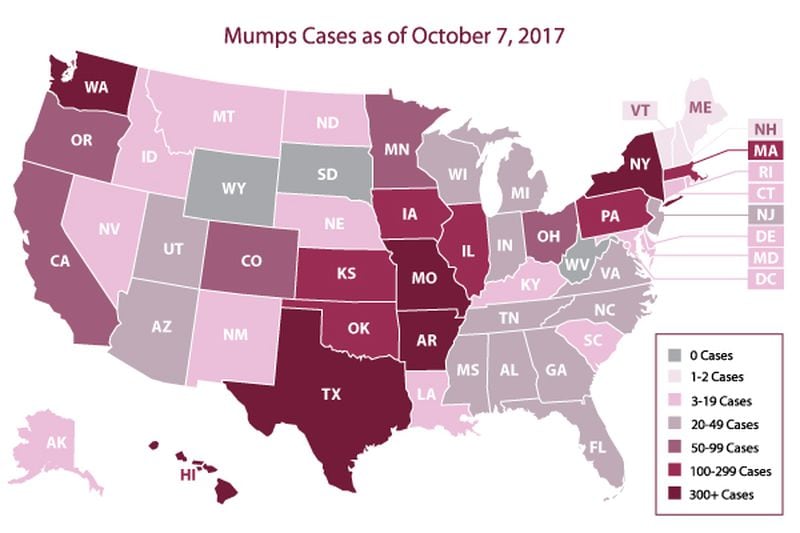Thousands of cheerleaders may have been exposed to mumps last month at the National Cheerleaders Association All-Star National Championships, Texas health officials said.
» RELATED: Health officials warn about mumps exposure at national cheerleading event
According to the Dallas Morning News, more than 23,000 cheerleaders and 2,600 coaches from 39 states and nine countries traveled to Dallas for the competition. One person with mumps also came to the event.
A letter was sent to all parents this week.
Last year, there were more than 6,000 cases of the contagious disease mumps reported in the United States — the highest number in 10 years.
» RELATED: Mumps outbreak spreads at Harvard, infecting dozens
That's according to the Atlanta-based Centers for Disease Control and Prevention, which recommends everyone 15 months and older should receive two doses of the M.M.R. vaccine, which protects against three diseases: measles, mumps and rubella.
There’s been a more than 99 percent decrease in mumps cases since the pre-vaccine era and in 2010, the total annual cases were down in the hundreds.
But in recent years, there have been multiple mumps outbreaks reported across the country.
In fact, the number of reported cases increased from 229 in 2012 to more than 6,000 cases in 2016.
The last major outbreaks occurred in 2006, when the U.S. saw more than 6,500 reported cases, predominantly in the Midwest and among college-aged students.
Between Jan. 1 and Oct. 7 this year, 47 states and the District of Columbia have reported approximately 4,667 cases to the CDC.
Syracuse University in New York confirmed 37 mumps cases Friday, an outbreak that began in August mainly among athletes on campus.
According to the Syracuse.com, to contain the outbreak, the CDC recommended those at risk receive an extra dose of the M.M.R. vaccine, a dose that helped control a mumps outbreak at the University of Iowa in 2015.
What causes mumps?
Mumps is caused by a virus and is spread through saliva, mucus (from the mouth, nose or throat) via sneezing, talking, coughing, sharing items like cups or utensils or touching areas with unwashed hands.
Due to the close proximity of students and athletes and other people on a college campus, many of the recent outbreaks have occurred in college towns.
"We are seeing it in other close-knit communities that tend to live closely together with strong social or cultural interactions," including religious groups, Janell Routh, a pediatrician and medical officer on the CDC mumps team told the New York Times.
Common symptoms of mumps, according to the CDC:
- fever
- headache
- muscle aches
- tiredness
- loss of appetite
- swollen and tender salivary glands under the ears on one or both sides (resulting in puffy cheeks and a swollen jaw)
These symptoms normally appear 16-18 days after infection.
If people are becoming immune to the M.M.R. vaccine, should the two-dose program still be administered?
Yes, according to Routh. “We know that two doses of M.M.R. decreases your risk of serious complications,” she said.
Such complications include inflammation of the testicles in post-pubertal males, inflammation of the ovaries and more dangerously, deafness and inflammation of the brain, she said.
The M.M.R. vaccine also protects against the more serious measles disease and rubella.
The third dose recommendation is meant for those deemed high risk by public health workers.
If there is a mumps outbreak near me, what do I do?
Be sure your M.M.R. vaccine is up to date, inform your doctor right away and make good hygiene a priority by washing your hands often with soap and water.
What do I do if I get mumps?
According to the CDC:
When you have mumps, you should avoid prolonged, close contact with other people until at least five days after your salivary glands begin to swell because you are contagious during this time. The time it takes for symptoms to appear after a person is exposed to the virus can range from 12 to 25 days. You should not go to work or school. You should stay home when you are sick with mumps and limit contact with the people you live with; for example, sleep in a separate room by yourself if you can. Staying home while sick with mumps is an important way to avoid spreading the virus to other people. People who are infected with mumps don't get sick right away—it can take 2 to 4 weeks for them to show signs of infection.
About the Author







